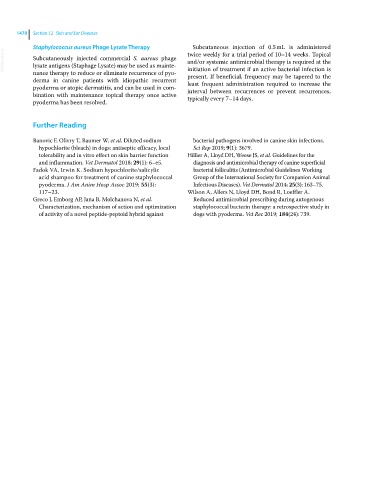Page 1532 - Clinical Small Animal Internal Medicine
P. 1532
1470 Section 12 Skin and Ear Diseases
Staphylococcus aureus Phage Lysate Therapy Subcutaneous injection of 0.5 mL is administered
VetBooks.ir Subcutaneously injected commercial S. aureus phage twice weekly for a trial period of 10–14 weeks. Topical
and/or systemic antimicrobial therapy is required at the
lysate antigens (Staphage Lysate) may be used as mainte-
nance therapy to reduce or eliminate recurrence of pyo- initiation of treatment if an active bacterial infection is
present. If beneficial, frequency may be tapered to the
derma in canine patients with idiopathic recurrent least frequent administration required to increase the
pyoderma or atopic dermatitis, and can be used in com- interval between recurrences or prevent recurrences,
bination with maintenance topical therapy once active typically every 7–14 days.
pyoderma has been resolved.
Further Reading
Banovic F, Olivry T, Baumer W, et al. Diluted sodium bacterial pathogens involved in canine skin infections.
hypochlorite (bleach) in dogs: antiseptic efficacy, local Sci Rep 2019; 9(1): 3679.
tolerability and in vitro effect on skin barrier function Hillier A, Lloyd DH, Weese JS, et al. Guidelines for the
and inflammation. Vet Dermatol 2018; 29(1): 6–e5. diagnosis and antimicrobial therapy of canine superficial
Fadok VA, Irwin K. Sodium hypochlorite/salicylic bacterial folliculitis (Antimicrobial Guidelines Working
acid shampoo for treatment of canine staphylococcal Group of the International Society for Companion Animal
pyoderma. J Am Anim Hosp Assoc 2019; 55(3): Infectious Diseases). Vet Dermatol 2014; 25(3): 163–75.
117–23. Wilson A, Allers N, Lloyd DH, Bond R, Loeffler A.
Greco I, Emborg AP, Jana B, Molchanova N, et al. Reduced antimicrobial prescribing during autogenous
Characterization, mechanism of action and optimization staphylococcal bacterin therapy: a retrospective study in
of activity of a novel peptide‐peptoid hybrid against dogs with pyoderma. Vet Rec 2019; 184(24): 739.

